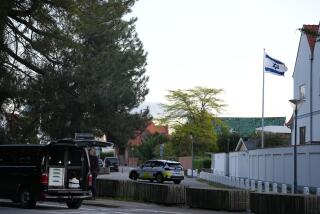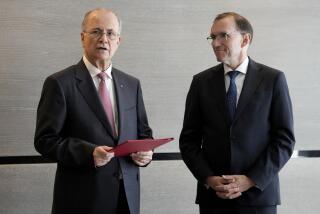In Berlin, Five Scandinavian Nations Share Embassy Space
- Share via
BERLIN — While Britons, Germans and French squabble about how much sovereignty should be sacrificed to a strengthening European Union, the five Scandinavian states have swept past their more powerful neighbors in the integration race by creating the Continent’s first communal embassy compound.
Germany’s recent move of its capital from Bonn to Berlin offered an opportunity for Sweden, Norway, Denmark, Finland and Iceland to deepen their regional cooperation and consult on common foreign policy by building a single diplomatic complex at the edge of this city’s lush Tiergarten park.
“This strikes a proper balance between our commitment to joint work for the region and the need to express individuality,” Mats Hellstroem, Sweden’s ambassador to Germany, says of the $60-million project to be inaugurated Wednesday with a visit by the heads of state of all five countries.
The Scandinavians have collaborated previously on cultural projects abroad, and the Nordic Council, which brings together the nations’ government chiefs twice a year, has been active since 1952. But the Berlin embassy project is unique in its bonding of the foreign interests of the five countries that have observed visa-free travel among their populations for 45 years, says Iceland’s ambassador here, Ingimundur Sigfusson.
The embassy project expresses a sense of community among the five countries that transcends their disparate interests in the Continent’s more formal alliances. Sweden and Finland have eschewed membership in the North Atlantic Treaty Organization in favor of neutrality, and Norway and Iceland have chosen to remain outside the 15-nation EU.
“For a non-EU nation like Norway, this arrangement offers us an interesting window on activities we are not ourselves involved in,” says Norwegian Ambassador Morten Wetland.
The sleek, six-building compound sheathed by glacial-green copper louvers, situated on prime real estate that belonged to Sweden and Finland before World War II, also makes an architectural contribution to the new face of Berlin that none of the individual countries, despite their wealth, could have justified to taxpayers on their own.
The five free-standing embassy components, of varying shapes and facades, are situated around a stone courtyard and set off from one another by shallow pools of water, “to symbolize the seas that both separate and link our countries,” says Inger Viklund-Persson of the Swedish Embassy.
The four-story embassies are bound by the surrounding wall of louvers to the Faelleshuset, the shared sixth structure, which houses a restaurant, conference facilities, security staff and galleries for art exhibits and entertaining.
Faelleshuset means “a house together” in Swedish, Norwegian and Danish.
Many other words are common to four of the five countries’ native tongues. That allows most of the hundreds of diplomats and employees in the compound to speak their own languages in what seems to outsiders a Tower of Babel. Only Finnish, of the obscure Finno-Ugric family, has no similarities to the languages of its Nordic neighbors.
“It works quite well,” says Denmark’s construction minister, Joergen Skov, on hand for the final building touches and the opening fanfare. “The Danes and Icelanders speak Danish. The Norwegians speak Norwegian. The Swedes speak Swedish. And, thank God, the Finns speak Swedish too.”
More to Read
Sign up for Essential California
The most important California stories and recommendations in your inbox every morning.
You may occasionally receive promotional content from the Los Angeles Times.














